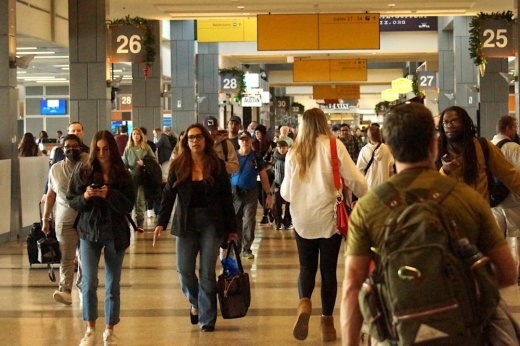In 2022, the city-owned airport experienced its busiest year on record. Officials anticipate that 2023 will break this record as passenger volumes continuously soar.
In June of 2020, ABIA officials projected that passenger levels would not return to what they were prior to the pandemic until 2024. Instead, the total passenger count from 2022 rose above what it was in 2019 by about 20%.
What's happening
ABIA spokesperson Sam Haynes says the growth can likely be attributed to an increased interest in Central Texas.
Austin is one of the top 15 largest cities in the United States and Georgetown was the fastest growing city in 2022, according to the U.S. Census Bureau.
"The story of Central Texas has always been growth," Haynes said. "That's why we're doing our airport expansion. It's to meet the needs of today while building out a foundation for long term success for our community."
The multi-year expansion program is funded by airport revenue and federal grants and will address the need of an increasing volume of travelers.The action taken
Spanning over multiple years, the airport’s expansion program consists of projects aimed at creating space and modernizing the airport that was first opened in 1999, said Haynes.
Active projects include a new baggage handling system for outbound checked bags; the West Gate expansion, which will extend the terminal out past gates 33 and 34 where Spirit Airlines is located; and an airline fuel facility.
On Aug. 30, officials broke ground on the West Gate expansion, which will add a total of 84,000 square feet across three levels.
In addition, the airport made strides toward its new midfield concourse project in 2023. A new 20-gate concourse, or area in which travelers pass through the airport, will connect to the Barbara Jordan Terminal by a tunnel underground, Haynes said.
In order to construct the new concourse, the airport acquired the South Terminal from its previous operator, LoneStar Airport Holdings LLC. The previous operator had a 40-year lease on the terminal that began in 2016, and the city settled for $88 million in a lawsuit to end the lease early. Operations of the South Terminal moved over to the city Nov. 1, and the terminal is up for removal by 2025.
“This year has been a lot of planning, preparation, sprinkling a little bit of groundbreaking, but it's really a lot of the behind the scenes work that has to get done before we start bringing projects online,” Haynes said.
In 2024, airport officials anticipate the completion of its jet fuel facility and a new cargo facility. The year will also see ground breaking on three projects.
The following are projects in the planning stages:
- A new multi-level parking garage that will support both short- and long-term parking for up to 30 days
- A new arrivals and departure hall to expand ticketing and check-in
- A new 20-gate concourse, or area which travelers pass through, that connects to the Barbara Jordan Terminal through an underground tunnel
- Improvements to the international facility that will include new baggage carousels and more queuing space
- Two parallel taxiways to connect the east and west sides of the building
- Ticketing-level atrium infill, which will fill in an open space with 13,000 square feet to avoid TSA lines from queuing outside
- West infill to expand TSA Checkpoint 3, which will add 16,000 square feet and add additional lanes to the TSA checkpoint
- New jet fuel facility
- new baggage handling system for outbound checked bags
- West Gate expansion, which will extend the terminal out past gates 33 and 34, where Spirit Airlines is located
This past year, city leaders and elected officials raised concerns about safety at the airport.
On Nov. 9, Austin City Council passed a resolution, authored by council member Vanessa Fuentes, that prompted action to develop a virtual ramp control system that will help navigate planes on the terminal ramp, the area where aircraft are parked and maintained. This came after an airline employee was killed in April and a city airport employee was killed in October due to accidents in this area.
“Instead of having a City of Austin employee stationed somewhere where they are looking at the ramp, like unobstructed watching the aircraft move on the ramp, we are simulating that in a room that's actually north of the terminal,” Haynes said of the virtual ramp control system.
In addition, Rep. Lloyd Doggett addressed the Federal Aviation Administration in a letter Oct. 16, urging the government agency to address low staffing of air traffic controllers at ABIA, citing it as a safety issue for the airport after multiple near-misses were reported.
“Austin is a growing city, and our airport must grow with it—including staffing up our air traffic control tower,” Doggett told Community Impact in an email.
As part of his requests, Doggett suggested increasing ABIA’s rank to a level 10 terminal facility, meaning the airport is classified as high activity, to reflect the airport’s growth and provide more compensation to air traffic controllers. Fuentes echoed this in her resolution.
“I really believe that [this resolution] will bring the necessary safety changes that the community requires in order for us to have a healthy operational airport,” council member Mackenzie Kelly said Nov. 9. In response to the resolution, an FAA spokesperson told Community Impact the agency is committed to safety.
“The FAA maintains extremely conservative standards for keeping aircraft safely separated, and multiple layers of safety protect the traveling public,” a spokesperson said.
Looking ahead
This past year, ABIA officials recorded nine dates as the airport's busiest ever. The Monday following formula 1 Grand Prix weekend, Oct. 23, was the airport's busiest day, with 43,243 passengers, according to airport data.
In 2024, Haynes said passenger's experiences may change as ABIA is under construction.
Airlines are also announcing changes such as American Airlines, which will cut 21 nonstop flights in 2024, including six international and 15 domestic destinations.
Despite the canceled routes, the airline will offer 19 additional daily departures on available routes compared to 2019, a spokesperson for the airline said. Travelers will also see new routes from other airlines, including a new nonstop route to Oregon from Allegiant, which will fly out of the South Terminal. Viva Aerobus will offer nonstop flights to Mexico beginning in March.
On Dec. 15, Delta Airlines announced 11 new flights and new routes out of ABIA, including service to Midland-Odessa and McAllen. This is a 20% increase in seat capacity from July 2023, according a news release.
To view this story as it appeared in the December print edition of Community Impact, click here.





